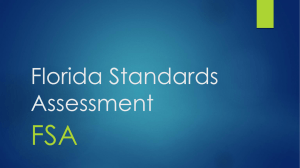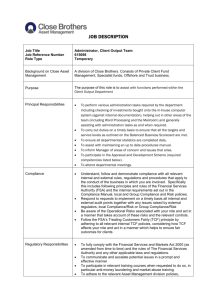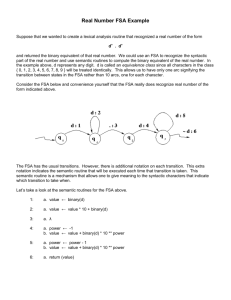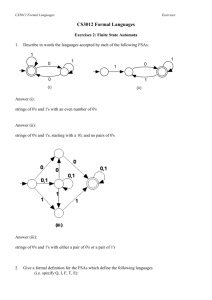The Joint Commission - Healthcare Accreditation Consultants
advertisement
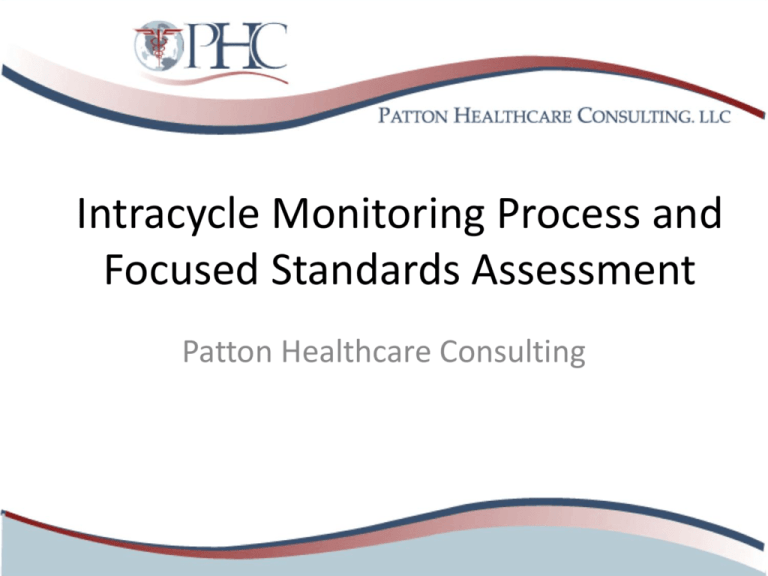
Intracycle Monitoring Process and Focused Standards Assessment Patton Healthcare Consulting Joint Commission -101 • The Joint Commission – Non-Profit – Accredits 80% of Hospitals in the Nation ~ 90%+ of the beds – Deemed Status Provider for Medicare Certification by CMS – Composed of Representatives of Professional Organizations Standards & Requirements • • • • • • • • • APR Environment of Care Emergency Management Human Resources Infection Control Information Management Leadership Life Safety Medication Management • • • • • • • • • Medical Staff NPSG Nursing Provision of Care Performance Improvement Record of Care Rights Transplant Safety Waived Testing Annual Internal “Self Assessment” Former Process known as Periodic Performance Review (PPR) • Required annually – though not due in year of survey • Due date established by TJC • Measures of Success (MOS) required for non-compliant EPs – Audit data to demonstrate your compliance once fixed – If requested had to be shown to surveyors during triennial survey – Results were used to help “guide” surveyors The New and Improved Intracycle Monitoring Process • PPR Process Retired as of Nov. 2012 • New Intracycle Monitoring (ICM) Jan 2013 – You will now submit a Focused Standards Assessment (FSA) – You still have same submission options – You can request a TJC call – You can submit specific questions/online chat – Surveyors will not ask for FSA MOS data 5 FSA Replaces the PPR • The new FSA is an abbreviated set of standards/EPs deemed to be high risk* • Will include high risk EPs – designated in manual with an “R” icon – most of direct impact and some indirect impact • About 500 EPs are “R” or high risk • NPSG are all “R”s • You will also have to score previous findings 6 High Risk* • • • • Proximity to the patient Probability of harm Severity of harm Number of patients at risk ICM Profile • An online workspace on your extranet site • Includes the FSA tool and quick links to FAQs, Leading Practice Library™, TST™, etc. • The FSA is required at approximately 12 and 24 months from last survey date • Not required at the 36 month anniversary • Full FSA submission, or options 1, 2, and 3 Full FSA or one of the 3 Options • According to TJC, historically – 75% of hospitals submitted the full PPR – 15% did Option 1 (attest that you did PPR) – 10% did either Option 2 or 3 (surveyor comes on site, Option 2 provided a written report, Option 3 = no report) – TJC would like to steer those who choose Option 1 to Full or Options 2 or 3 – Option 2 or 3 survey limited to just FSA The FSA Tool • The AMP tool is designed to be “pulled in” from the ICM Profile extranet page • It is auto-loaded with the risk-selected FSA standards/EPs/ NPSGs • Along with the standards/EPs found non-compliant in your last survey • Capability for on-the-fly free-text/chat questions to Standards Interpretation Sharing Options with ICM Profile • Onsite survey teams have access to – Previous survey findings and follow up reports – Accreditation application data – ORYX Reports, Quality Check Reports • You may “opt-in” to allow the onsite team to see the full ICM profile with or without your FSA (self-assessment) ICM/FSA Goals • You are scoring as if you were the Surveyor to determine compliance! • Rigorously complete the FSA tool – Score yourself at each applicable EP – Identify where evidence that you are compliant can be found (annotate) – Identify areas of weakness/vulnerability – Identify data that demonstrates compliance Scoring Basics: What You Score Yourself On • You must be compliant with: – The applicable standards/EPs including the situational decision rules – The FAQs published by the Joint Commission – Anything in Perspectives – Your own internal policies • The surveyor will hold you to the most stringent where differences exist! 13 Read the Book 3/10/2016 14 READ THIS NEWSLETTER Get it Distributed And Look on the Website, Print All FAQ’s http://www.jointcommission.org/AccreditationPrograms/Hospitals/Standards • Standards • Consist of Three Parts: – Standard Statement – Rationale and/or Notes (not in the excel file) – Elements of Performance (EP) • These are the score-able elements FSA Scoring Sample The CAMH Scoring of Standards • Standards are NOT scored per se • You score only the Elements of Performance (EP) under the standard • If one EP is non compliant or partial, the standard is considered non compliant by The Joint Commission. How EP’s are Scored • Category A – Relate to structural and process requirements, such as policy – Scored as either exist or not. Either compliant or not. All or nothing. How EP’s are Scored • Category C – Based on the number of times you do NOT meet a EP – Scored by the surveyors as: • 0 = Insufficient Compliance = 3 or > instances of noncompliance • 1 = Partial Compliance = 2 instances of non-compliance • 2 = Satisfactory Compliance = 0 – 1 instance of noncompliance – In other words …. Two observations is NON-COMPLIANT How EP’s are Scored • “D” for Documentation Requirement • Conceptually a great idea – identify those issues where you just have to do it vs. those where you have to do it, and document that you did it. • Many D’s appear to be missing; when the body of the EP says document o Example: NPSG.08.02.01, EP 1 – Communicate the medication reconciliation list and the communication among providers is documented. • Many C elements with MOS, but no D – how would you measure these? How EP’s are Scored: – Measure of Success • Some EP’s have a “Measure of Success” (MOS) associated with them. • Requires an Audit - a quantifiable measurement if found out of compliance during FSA or on-site survey. • Remember this important change! The on-site surveyor may no longer request to see your historical MOS data on any EP you found out of compliance on a previous PPR or FSA. (Though you may opt-in to let them view your FSA results) MOS – Sample Size • Sample Size Requirements for Category C Standards – Recommended for use in FSA • Population size up to 100 = 30 cases or 100% if < 30 • Population size 101 – 500 = 50 cases • Population size > 500 = 70 cases SEVERITY LEVELS FOR EP’S Immediate Threat 2 3 “Situational” CONT / PDA Decision Rules Direct Impact – 45 days Indirect Impact - 60 days 25 Situational Decision Rules Short Cut to Trouble Immediate Threat 2 3 “Situational” Decision Rules Direct Impact • Severity “2” • Very bad news, may result in Preliminary Denial (PDA) decision • Examples include: o Unlicensed practice o “Busted plan” o Failed ILSM or Failure to Assess for ILSM o Use of surveyors as consultants o Falsification Indirect Impact Situational Decision Rules cont. Immediate Threat 2 “Situational” Decision Rules 3 Direct Impact Indirect Impact New Decision Rules CONT02 – Failure to resolve all prior findings that resulted in Accreditation with Follow Up (AFU) • CONT03 – Credible evidence indicates possible fraud has occurred. New Survey Type: • Accreditation with Follow Up (AFU08) an onsite follow up survey w/in 45 days in Medicare certified hospitals for a condition level deficiency(s) • (AFU01-02) Systemic pattern of repeat findings of direct or indirect standard • AFU03 Failure to address all RFI in an ESC/MOS For Each Standard/EP • Ask yourself, ask your staff: – Do we do this? – Where is it written we do this? – How well, or how often do we do this? – Show me the evidence that we do this – Validate the “doing” with high risk and high priority standards 28 FSA Scoring – How To: Complete the sections for: • Annotate Supporting Evidence – (Policy # and/or Data) • • • • Observations Compliant? Yes/No Action Items Responsible Person In summary: Why Do the FSA? • • • • • It’s required! Get staff ready for the survey Find it before the survey team does Allows you to fix it or find another way Focus on – Actual performance – Execution, not your potential to do it right • Assemble evidence that you are at least 90% compliant for those things that are frequently scored. You are huge. Measure internal compliance • Opportunity to request resources, if needed. FSA Focuses on the Priority Issues • The 2013 standards have 1900 EPs that can be scored • The Joint Commission does >90% of its scoring on about 25 standards/NPSGs – Focus on the top scored direct and indirect EPs – Focus on all NPSGs – Focus on any NEW standards or FAQs – Focus on previously scored issues 31 The FSA is Complete, Now What? Bullet Proof Weak Areas • Internal FSA tracers/data will highlight these • Formalize decisions in writing, do risk analysis, communicate decisions • Communicate top hot spots – In pocket guides, in games, in annual education, screen savers, table tent cards – Engineer to sustain compliance • Make the right thing to do the easiest thing to do 32 Questions? • Kurt Patton – Kurt@PattonHC.com • Jennifer Cowel – JenCowel@PattonHC.com • John Rosing – JohnRosing@PattonHC.com • Mary Cesare Murphy – MCM@PattonHC.com
